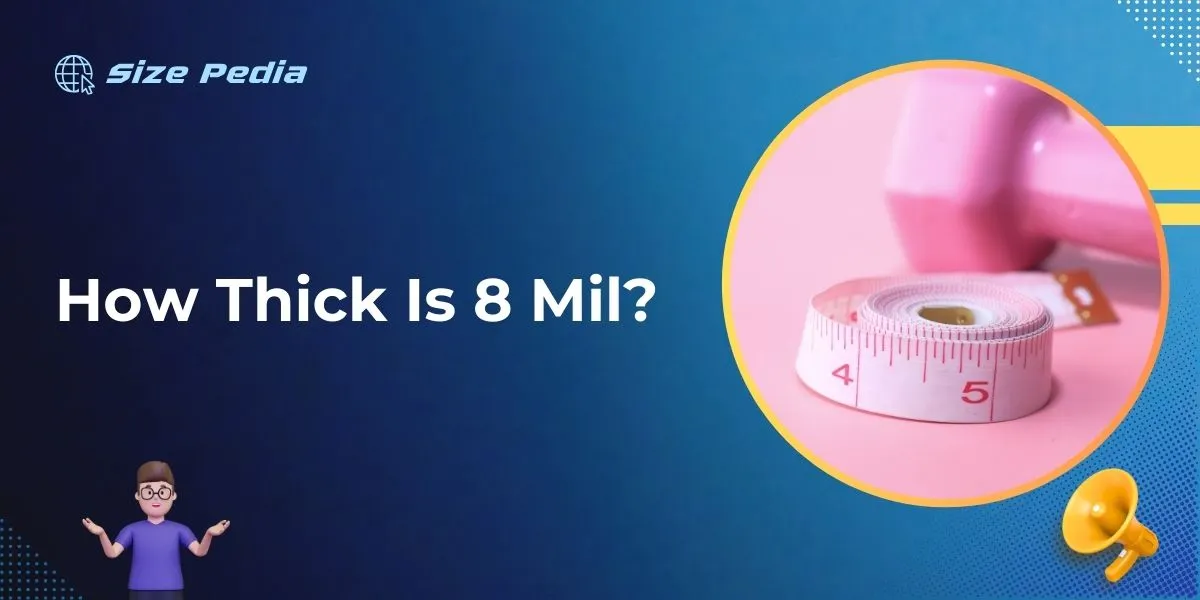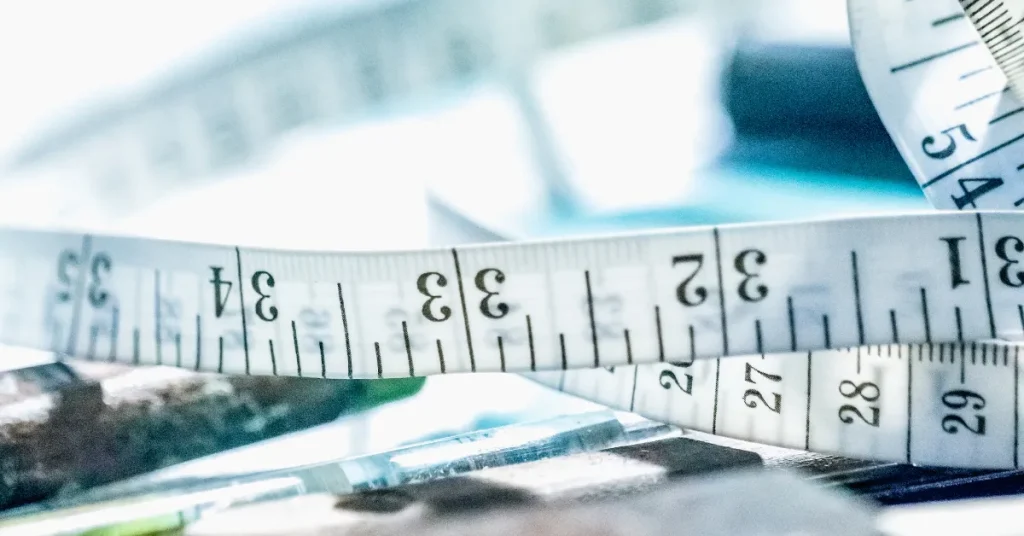An 8 mil thickness is equivalent to 0.008 inches or 0.2032 millimeters. This measurement is often used in reference to materials like plastic sheeting or laminates.
Understanding material thickness is crucial in industries ranging from construction to printing. The term ‘mil’ is a measurement unit that should not be confused with millimeters, as it specifically denotes one-thousandth of an inch.
An 8 mil thickness strikes a balance between durability and flexibility, making it a popular choice for various applications including protective covers, barriers, and graphic print materials.
Manufacturers and consumers alike prefer this thickness for its strength without significant rigidity, ensuring it can withstand handling and use while maintaining its form.
Products with an 8 mil specification provide a reliable standard for performance and quality in projects requiring a mid-range material thickness.

The Measure Of Mil Explained
What exactly is a “mil,” you might wonder? Simply put, a mil is a unit of measurement. It is not a millimeter. It is not a mile.
A mil is a thousandth of an inch. This may sound tiny, but in certain contexts, especially in manufacturing and engineering, it’s a critical measurement.
Let’s delve deeper into what a mil stands for, especially when we’re talking about the 8 mil mark.
Breaking Down The Mil Unit
Understanding the mil unit is easier than you think. A single mil is one thousandth (1/1000) of an inch. To visualize it, imagine the thickness of a dollar bill.
That’s about 4 mils thick. So, an 8 mil sheet would be twice as thick as that dollar bill. Remember, mil is short for “milli-inch”.
Here’s a quick breakdown in bullet points:
- 1 mil = 0.001 inch
- Dollar bill thickness ≈ 4 mils
- 8 mils = 0.008 inches
Comparing Mil To Other Measurement Systems
Let’s compare the mil to other measurement systems to grasp its size:
| Measurement System | Equivalent to 1 Mil |
| Inches | 0.001 inches |
| Millimeters | 0.0254 millimeters |
| Centimeters | 0.00254 centimeters |
| Microns | 25.4 microns |
Remember, different industries use different units. So, it’s important to know how a mil measures up.
From protecting your smartphone screen with a thin film to sealing products in thick bags, a mil makes a big difference. Take an 8 mil barrier: it’s tough, reliable, and precise.
That’s equivalent to 0.008 inches or 0.2032 millimeters. In micron terms, it’s a substantial 203.2 microns thick. Whichever way you measure, that’s real protection.
The Real-world Thickness Of 8 Mil

8 mil thickness might sound technical, but it’s quite simple to grasp. Think of a mil as a unit of measurement used commonly in America to gauge the thickness of various materials. It’s a shorthand for one-thousandth of an inch.
Therefore, 8 mil is equal to .008 inches. To put that into perspective, it’s about twice as thick as a common plastic grocery bag which is typically around 4 mils.
Common Materials That Share 8 Mil Thickness
- Heavy-duty kitchen trash bags – Designed to hold more without tearing.
- Contractor bags – They are sturdy and used for rough, heavy, or sharp waste.
- Laminating sheets – Often found in schools or offices to protect documents.
- Painters plastic sheeting – Protects floors and furniture while painting.
- Window insulation kits – Used to seal windows during the cold months.
Visualizing 8 Mil In Everyday Life
To help you visualize the thickness of 8 mil, imagine the following scenarios:
- Stacking two standard business cards – That’s close to 8 mil thick.
- Layering a few pieces of hair – A single strand of hair is about 1 mil, so 8 would match.
- A dime’s edge – It’s a bit thicker than 8 mil but offers a ballpark idea.
Applications Where 8 Mil Plays A Crucial Role
Imagine something as thin as a sheet of paper, but with incredible strength. That’s 8 mil for you. At just 0.008 inches thick, 8 mil material plays a vital role in various applications. It is sturdy, flexible, and often clear.
It protects, seals, and enhances products we use daily. In this post, we’ll explore the critical uses of 8 mil across different industries.
Industrial Uses For 8 Mil Materials
8 mil material is a hero in industrial settings. It shows up in unexpected places:
- Protective covers: Machines stay clean and safe.
- Insulation: Pipes and wiring stay warm and efficient.
- Barrier films: These keep moisture out, preserving freshness.
- Construction: Durable liners and covers aid in building.
8 Mil In Consumer Products
At home, 8 mil is everywhere. Thanks to its robustness and clarity, it’s perfect for everyday items:
- Window films: They block UV rays, saving energy.
- Protective packaging: Items arrive safely to you.
- Laminating pouches: Documents stay crisp and readable.
- Table covers: Spills wipe clean in a swipe.
Importance Of 8 Mil In Security Features
8 mil thickness goes beyond just protection and utility. It also provides enhanced security:
- ID badges: Tough and tamper-resistant, keeping data secure.
- Anti-theft packaging: Harder to open, deterring thieves.
- Safety glazing: Shatter resistance adds an extra layer of protection.
- Tamper seals: Ensures product integrity from production to purchase.
Making Sense Of 8 Mil Measurements
Making Sense of 8 Mil Measurements is like understanding a secret language of thickness. In the world of materials, “mil” often confuses people. It’s actually quite simple. One mil is one-thousandth of an inch. Now, 8 mil means it is 8 thousandths of an inch thick.
This thickness is common for various products. Think of protective covers or plastic sheets. Understanding this unit can help you choose the right thickness for your needs.
Tools To Measure 8 Mil
To get the thickness right, precise tools are a must. The most common tools include:
- Micrometer: A precision device that can measure small distances.
- Calipers: Ideal for measuring the thickness of various objects.
- Gauge Meter: Often used for materials like plastics or metals.
These tools ensure your measurements are accurate. So when you read “8 mil”, you can verify it easily.
Converting 8 Mil To Other Units
Sometimes, you need to convert mils to other units. Here is how 8 mils stack up:
| Unit | Measurement |
| Inches | 0.008″ |
| Millimeters | 0.2032 mm |
| Centimeters | 0.02032 cm |
| Meters | 0.0002032 m |
This table helps to visualize how 8 mil translates into other measurements.
Misconceptions Surrounding The Thickness Of 8 Mil

Misconceptions abound about the thickness of materials measured in mils. The term ‘8 mil’ can be especially tricky. Let’s clear up the confusion around this measurement. The real facts may surprise you.
Debunking Common 8 Mil Myths
Many people think 8 mil means 8 millimeters. This is not true. 1 mil is 1/1000th of an inch. Therefore, 8 mil is just 0.008 inches thick. It’s a tiny measurement that requires precision.
- Myth: 8 mil is always the same, no matter the material.
- Fact: Material type changes how thick 8 mil feels.
Say goodbye to confusion. Focus on both mils and material types for a true understanding.
Why Mil Thickness Can Be Deceptive
8 mil might sound thin. Yet, this measurement can provide significant durability. Context is key. For example, plastic sheeting and laminate film in 8 mil can have very different feels and uses. Check the table below for a clear perspective:
| Material | Perceived Durability |
| Plastic Sheeting | Sturdy and Water-resistant |
| Laminate Film | Flexible and Tear-resistant |
Don’t let mils fool you. Look deeper into use and material to grasp true thickness and strength.
Exploring The Significance Of 8 Mil
Let’s dig into the world of materials and measurement. When you see the term ‘8 mil’, it refers to thickness. Often used in the context of plastics and protective coatings, ‘mil’ is a unit of measurement. It equals one-thousandth of an inch. So, 8 mil is .008 inches thick.
Impact Of 8 Mil On Durability And Performance
The 8 mil benchmark is popular for reasons tied to its balance of flexibility and strength.
- It withstands wear and tear better than thinner materials.
- Offers improved protection with minimal bulk.
- Perfect for items needing a durable, yet not rigid, barrier.
Some common uses include plastic sheeting, protective covers, and adhesive films.
| Application | Benefit of 8 Mil |
| Construction Film | Resists punctures and tears |
| Lamination | Enhances document longevity |
| Window Films | Provides insulation and UV protection |
Choosing The Right Thickness For Your Needs
Selecting the ideal thickness is crucial. It depends on your project requirements.
- Identify the purpose: Is it for insulation, waterproofing, or protection?
- Consider the environment: Will it face extreme temps or chemicals?
- Understand the material’s properties: Some materials perform differently at various thicknesses.
An 8 mil thickness provides a happy medium for most applications.
For precise durability, context is key. Define your use-case first.
FAQs About How Thick Is 8 Mil
How Thick Is A Mil In Inches?
One mil is equal to 0. 001 inches. This measurement is often used in manufacturing and engineering for thickness.
How Thick Is A Mil Of Plastic?
A mil of plastic is 0. 001 inch thick. This measurement equals approximately 0. 0254 millimeters.
Is 4 Mil Plastic Thicker Than 8 Mil?
No, 4 mil plastic is not thicker than 8 mil. Eight mil plastic is double the thickness of 4 mil plastic.
How Thick Is 8 Mil In Mm?
An 8 mil thickness converts to approximately 0. 2032 millimeters.
Conclusion
Understanding the specifics of 8 mil thickness is key for countless applications. It’s a mere 0. 008 inches, yet vital for durability and protection.
Selecting the right material thickness, like 8 mil, can make a significant difference in your project’s success, ensuring both quality and longevity.
Always choose wisely, keeping your needs front and center.
Resources:
1. https://www.discountvisqueen.com/mil-thickness-to-mm-and-inches.php
